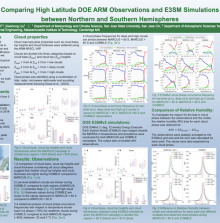Comparing High Latitude DOE ARM Observations and E3SM Simulations between Northern and Southern Hemispheres
Neel
Desai
San Jose State University
Poster
High-latitudinal cloud cover, cloud phase and underlying microphysics play an important role in determining the surface radiation budget which can affect regional and global precipitation patterns. In this study, we compare cloud microphysical and macrophysical properties observed in northern and southern high-latitudinal regions based on two DOE ARM field campaigns, i.e., the DOE ARM Cold-Air Outbreaks in the Marine Boundary Layer Experiment (COMBLE) and the Measurements of Aerosols, Radiation, and Clouds over the Southern Ocean (MARCUS) field campaigns, respectively. We also evaluate DOE E3SMv2 simulation results for both campaigns and compare the results against the observations.
Clouds are divided into three categories based on cloud top heights: stratiform, convective and high clouds. Cloud cover analysis indicates a higher percentage of convective clouds during COMBLE compared with MARCUS. Regarding cloud macrophysical properties of stratiform clouds, COMBLE observations show higher cloud top heights and thickness compared with high-latitudinal observations (> 60° S) in MARCUS, and show similar values compared with mid-latitudinal cloud properties (≤ 60° S) in MARCUS. A statistical analysis of cloud microphysical properties, specifically cloud phase frequency with respect to temperature, shows lower ice phase and higher liquid phase frequencies between -20° C and 0° C during COMBLE compared to MARCUS high latitude observations. The DOE E3SMv2 simulations suggest an overestimation of liquid and mixed phase and an underestimation of ice phase compared with observations. Such a hemispheric analysis will provide a valuable comparison between high-latitude regions of both hemispheres as well as help improve high latitude cloud parameterizations in GCMs.
Clouds are divided into three categories based on cloud top heights: stratiform, convective and high clouds. Cloud cover analysis indicates a higher percentage of convective clouds during COMBLE compared with MARCUS. Regarding cloud macrophysical properties of stratiform clouds, COMBLE observations show higher cloud top heights and thickness compared with high-latitudinal observations (> 60° S) in MARCUS, and show similar values compared with mid-latitudinal cloud properties (≤ 60° S) in MARCUS. A statistical analysis of cloud microphysical properties, specifically cloud phase frequency with respect to temperature, shows lower ice phase and higher liquid phase frequencies between -20° C and 0° C during COMBLE compared to MARCUS high latitude observations. The DOE E3SMv2 simulations suggest an overestimation of liquid and mixed phase and an underestimation of ice phase compared with observations. Such a hemispheric analysis will provide a valuable comparison between high-latitude regions of both hemispheres as well as help improve high latitude cloud parameterizations in GCMs.

desai-neel-polar-poster.pdf
(1.67 MB)
